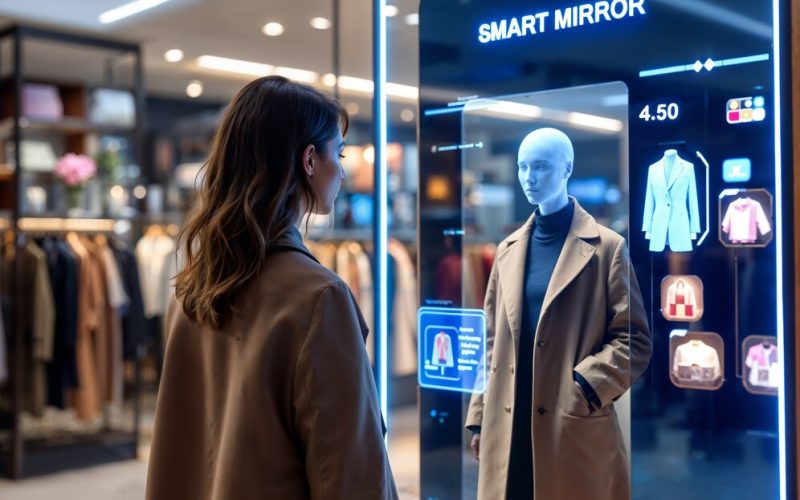Augmented Reality (AR) is reshaping how we experience and interact with the world around us, overlaying digital information—graphics, sounds, and even sensory data—on the physical environment in real-time. What was once science fiction has become a transformative tool across multiple industries, offering applications that extend beyond gaming into retail, wearables, education, and entertainment. This article dives into the latest advancements in AR, including emerging technologies like Meta’s Orion AR glasses and Apple’s Vision Pro headset, along with the practical applications and benefits they bring. We’ll also explore the ethical considerations that come with such innovations.
Emerging AR Technologies: Pioneers and Innovations

In recent years, major players like Meta, Apple, and Disney have propelled AR technology forward, each with a unique approach to enhancing the immersive experience.
Meta’s Orion Holographic AR Glasses
Meta is pushing the boundaries with its holographic AR glasses, known as Orion. Orion’s lightweight design (under 100 grams) is equipped with a neural interface worn on the wrist, allowing users to control the interface through subtle movements. Though still in prototype stages, Orion represents a leap toward wearable AR that is less obtrusive and more integrated into daily life. Meta’s goal is to create glasses that allow for effortless real-world applications, from live translations to interactive navigation.
Apple’s Vision Pro Headset
Apple has entered the AR market with the Vision Pro, which blends augmented and virtual reality for an immersive, mixed-reality experience. With its high-resolution display and advanced sensors, the Vision Pro is designed to deliver seamless interaction with virtual content within a user’s real-world surroundings. In collaboration with broadcasters like Channel 4 in the UK, Apple is leveraging the Vision Pro to bring immersive media experiences to consumers, adding depth to digital storytelling.
Disney’s Integration of AR and AI
Walt Disney is exploring AR and artificial intelligence (AI) to enhance customer experiences through a new business unit dedicated to coordinating technology integration. This division seeks to elevate consumer engagement by offering interactive experiences that merge physical and digital content in Disney’s parks, media, and merchandise.
Benefits of Augmented Reality
Augmented Reality offers numerous advantages across various sectors, from retail to daily wearables, creating personalized experiences and enhancing customer engagement.
Enhanced Consumer Engagement
One of the significant benefits of AR is its ability to immerse consumers in experiences that feel personal and interactive. By overlaying digital content on physical products or environments, AR makes interactions memorable, creating a lasting impression and driving customer loyalty.
Personalized Shopping and Try-On Experiences
Retail is rapidly adopting AR to enhance the shopping experience. Stores like Valentino Beauty and Shiseido use AR to provide virtual try-ons for beauty products, allowing customers to visualize makeup or skincare products before purchasing. This technology personalizes the shopping experience, reduces returns, and gives consumers more confidence in their choices.
Innovation in Wearable Devices for Daily Life

Wearable AR devices such as Meta’s Orion glasses and Apple’s Vision Pro headset represent a shift toward practical AR applications for everyday use. By integrating AR into lightweight, comfortable designs, these devices could become as ubiquitous as smartphones, enabling real-time assistance, navigation, and even health tracking.
Streamlined Marketing and Advertising Strategies
AR is a powerful tool for marketers to reach consumers in a unique and interactive way. Brands can create AR ads that allow users to “place” products in their own space, such as virtually positioning furniture in a room or seeing how a new car might look in their driveway. This kind of engagement makes advertisements more impactful and memorable.
Real-World Applications and Examples of AR
Several industries are leading the way in AR adoption, creating immersive experiences that blend physical and digital realities.
AR in Physical Retail Stores
Retailers like Valentino Beauty and Shiseido use AR in-store to offer virtual try-ons, enhancing customer engagement and satisfaction. This approach allows users to visualize products on themselves without physically trying them on, making the shopping process faster and more hygienic, especially in beauty and fashion sectors.
Daily Wearable AR Devices
With Meta’s Orion glasses and Apple’s Vision Pro, wearables are becoming essential tools for augmented reality in daily life. These devices are designed to integrate seamlessly with daily activities, providing real-time information, navigation, and social interaction aids. Imagine walking down a street and having your AR glasses identify restaurants, display reviews, or even show turn-by-turn navigation.
AI and AR Integration in Robotics and Public Experiences

OpenAI has recently appointed Caitlin Kalinowski, Meta’s former head of AR glasses hardware, to lead its efforts in robotics and consumer hardware, hinting at new possibilities for combining AI and AR. This integration could allow for interactive robots that assist users in public places, or AR tools that respond to voice commands, enhancing both work and recreational environments.
Privacy and Ethical Considerations in Augmented Reality
As AR technology progresses, so do the concerns surrounding privacy and ethics, particularly with developments in facial recognition and real-time data processing.
Privacy Concerns with Facial Recognition Technology
Some AR glasses come equipped with real-time facial recognition capabilities, raising significant privacy concerns. While these features can enhance convenience, such as identifying contacts in real time, they also pose risks of misuse. Unauthorized data collection and facial recognition could lead to privacy violations if not managed responsibly.
The Need for Ethical Guidelines and Privacy Laws
To address these concerns, there is a growing call for ethical guidelines and regulatory oversight. Policymakers are being urged to consider legislation that protects individuals’ privacy and establishes guidelines for responsible AR use. By setting ethical boundaries, companies can create safe, consumer-friendly AR experiences while respecting privacy rights.
Benefits of AR for Businesses and Consumers Alik
Augmented Reality has the potential to bridge the gap between digital and physical, creating benefits for both businesses and consumers.
Businesses Gain Competitive Edge
AR helps businesses differentiate themselves in competitive markets. Retailers that embrace AR can stand out with unique, interactive experiences, drawing consumers who are increasingly expecting high-tech interactions in shopping environments.
Consumers Enjoy More Informed Purchase Decisions
For consumers, AR helps in making better purchasing decisions. Virtual try-on and product visualization help customers feel confident in their choices before buying, reducing the likelihood of returns. For instance, with furniture or home decor purchases, AR apps allow customers to see how items will look in their home, improving customer satisfaction.
Conclusion: The Expanding Influence of AR
Augmented Reality is here to stay, and its impact will only deepen as technology becomes more sophisticated and accessible. From enhancing daily wearables to transforming retail and entertainment, AR is poised to bring the digital and physical worlds together in new, exciting ways. Yet, as we continue to innovate, it’s crucial to approach AR’s expansion with caution and respect for ethical boundaries, ensuring that the benefits of this technology can be enjoyed responsibly and inclusively.
With developments from major companies like Meta, Apple, and Disney leading the way, the future of AR promises experiences we can only imagine today. But as we look to this future, it’s equally important to navigate the ethical landscape to ensure that this powerful technology serves as a force for good in the lives of all users.












